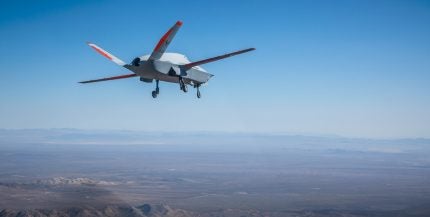
The maiden flight of General Atomics’ XQ-67A Off-board Sensing Station validated a cost-effective method of uncrewed system development.
XQ-67A is the first of a second generation of autonomous collaborative platforms, or ACP. It follows the success of the XQ-58A Valkyrie, the first low-cost uncrewed air vehicle (UAV) intended to provide the operator with credible and affordable mass.
The XQ-67A’s first ever successful flight from Gray Butte Field Airport in California on 28 February 2024 proves the common chassis or “genus” approach to aircraft design, build and test, according to Doug Meador, autonomous collaborative platform capability lead with AFRL’s Aerospace Systems Directorate.
This approach paves the way for other aircraft “species” to be rapidly replicated on a standard genus chassis.
“This approach will help save time and money by leveraging standard substructures and subsystems, similar to how the automotive industry builds a product line,” Meador stated.
“From there, the genus can be built upon for other aircraft — similar to that of a vehicle frame — with the possibility of adding different aircraft kits to the frame, such as an Off-Board Sensing Station or Off-Board Weapon Station.”
How well do you really know your competitors?
Access the most comprehensive Company Profiles on the market, powered by GlobalData. Save hours of research. Gain competitive edge.

Thank you!
Your download email will arrive shortly
Not ready to buy yet? Download a free sample
We are confident about the unique quality of our Company Profiles. However, we want you to make the most beneficial decision for your business, so we offer a free sample that you can download by submitting the below form
By GlobalDataHowever, this does not blemish the success of its predecessor. The US Marine Corps recently completed the testbed UAV’s second test flight on 23 February 2024.
This seconf flight test serves as a key milestone in implementing ‘Project Eagle’, the Marine Corps’ aviation modernisation strategy in support of broader Force Design modernisation efforts.
XQ-58A and other Project Eagle research and experimentation platforms will inform capabilities needed in future conflicts out to 2040.
“The future battlespace demands new aviation platforms that embrace the austere environment and bring the fight to the enemy at a place of our choosing,” asserted Lieutenant Colonel Bradley Buick, future capabilities officer for the Cunningham Group.







